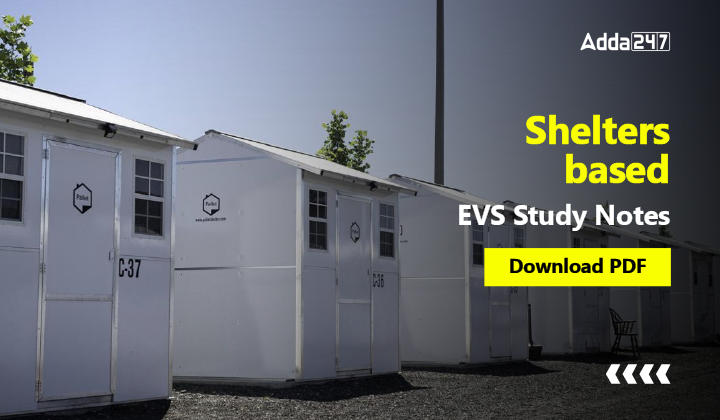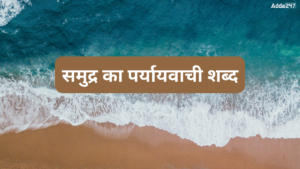Table of Contents
Environmental Studies is a multidisciplinary field encompassing various branches such as chemistry, physical science, life science, agriculture, health, and sanitary engineering. It is an engaging subject, featuring 30 questions in CTET and other State TET exams. To prepare effectively for the CTET exam, it is recommended to study NCERT books from classes 1 to 8. This article provides introductory insights on Environmental Studies, followed by some interesting facts related to the subject.
What is the Shelter?
A shelter is a place where both animals and humans live, offering protection from the weather and various dangers. It provides a safe space for resting and carrying out everyday activities. Additionally, a shelter offers privacy and storage for personal belongings.
Types of Shelter
- Permanent Shelter: Places where humans or animals live for long durations and spend most of their time, such as houses, caves, and bird nests.
- Temporary Shelter: Places where animals and humans stay for short periods or specific purposes, including bus shelters, houseboats, migratory bird nests, tents, caravans, and shelter homes.
Animals and Their Shelter
- Land and Forest Dwellers: Cow, dog, donkey, horse, lion, elephant, deer, rhinoceros, peacock.
- Tree Dwellers: Monkey, birds, sloths, apes.
- Burrow Dwellers: Rats, snakes, ants, rabbits, earthworms, scorpions.
- Both Land and Water Dwellers: Snake, crocodile.
Birds and Their Shelter
• Indian Robin: It makes its nest on the top of the tree with grass, soft twigs, roots, wool, hair and cotton wool. It lays its eggs between the stone.
• Koel: It does not make its nest. It gives eggs in the nest of crow and crow hatches them with its egg.
• Crow: The crow makes its nest high up on a tree and it makes its nest using wire, wood, grass and twigs.
• Sparrow and Pigeon: These birds make their nest in the buildings usually. On the top of the cupboard, behind a mirror, on a ventilator.
• Tailor Bird: It makes its nest by weaving and stitching the leaves. It uses its sharp beak to stitch the leaves on a bush. It lays eggs in the fold of a leaf that it has made.
• Barbet: Barbet or coopersmith makes its nest in a hole or in a tree trunk.
• Dove: The dove birds make their nest among the thorn of a cactus plant or in a mehendi hedge.
• Sun Bird: It makes a nest that hangs from the branches of a small tree or bush. The nest is made with hair, grass, thin twigs etc.
• Weaver Bird: Male weaver birds make their nest for the female. It makes a beautifully woven nest for females to lay eggs.
Insects and Their Living Habits
Human Shelter:
The shelter of humans is called a house. House can be of two different types:
• Kutcha houses are made up of wood, mud, straw etc. e.g. hut.
• Pucca houses are made up of bricks, cement, sand, iron, wood and steel. e.g. apartments, flats, bungalows etc.
Various factors play an important role in deciding the choice of shelter and some of these factors are following
• Location and Geography of Area: Different style of houses is found in deserts, hilly areas plains etc.
• Environmental Condition: Rainfall, temperature seasons like summer, winter etc. These factors decide the choice of house in a specific area.
• Availability of Raw Material in Local Area and Economic Status of Individual: Raw materials that are easily and economically available are preferred materials for the construction of houses. The economic status of an individual also decides the type of house he can afford.
Specific Houses in Specific Areas
1. House made up of Mud:
• These houses are found in hot deserts of Rajasthan and in villages.
• These houses help in better adapting to excessive heat, mud walls of these houses are made thick so that heat does not cross them.
• Roots are made up of fooder and bushes, and wood Acacia (kikar) is used on the roof in order to protect the roof from insects.
• These houses are painted with mud and cow dung to protect the mud from breaking and for protection against insects.
2. House made up of Wood and Bamboo:
• These houses are made in those areas where there is very heavy rain. These bamboo and wood houses are 10-12 feet above the ground so that they remain unaffected by flood.
• These houses are found in Assam and in some other parts of North – East.
3. House made up of Stone:
Stone houses are found in the cold desert of Ladakh and other hilly desert areas.
• The walls are coated with a thick layer of mud and lime. The thick tree may be used to make the roof of the first floor strong and wooden floors, wooden ceilings are also found in the houses.
• In two two-story buildings of Ladakh, on the ground floor necessary things and animals are kept and on the first floor, people live. The ground floor does not have windows.
• In intense cold people can shift to the ground floor. On the roof of the house, vegetables and fruits are kept for drying.
4. House made up of Stone and Wood:
• These houses are found in hilly areas where there is a good amount of rainfall and snowfall.
• Roofs of these houses are sloping on the sides so that snow and rain can fall easily on the ground. These houses may be made up of stone, bricks and wood.
• These houses can be found in Srinagar, Manali and other areas of Kashmir valley. Houses in Srinagar display beautiful carvings of wood on the ceiling ofthe house; doors and windows have beautiful arches known as Mehraab.
5. House Boat:
• Houseboats are made up of wood and are present in water. These houses can be up to 80 feet long and 8-9 feet wide.
• These houseboats have beautiful wooden carvings on them and these carvings are known as khatamband These houseboats are found in Kashmir and Kerala.
6. Fort and Palace:
• These buildings were made in earlier times by kings and emperors.
• These buildings were very big and had a large number of rooms.
• Walls and ceilings of these buildings have designs and motifs on it.
• Donga: Donga is housed in water, the house is present on the boat, with different rooms in it. It can be seen in Dal Lake Kashmir.
• Igloo: Igloo is found in very cold regions. These houses are made up of ice blocks. The shape of the Igloo is oval shaped and the entry door of the Igloo is very small. Eskimos live in the Igloo.
• Tent House: Tent house offers a temporary shelter; tent house can be made up of plastic and clothes. Mountaineers use such houses and they make them using two-layer plastics. The hangpa tribe of Ladakh used yak hair woven strips to make the big coned-shaped tent. They call their tent Rebo.
Shelter Notes PDF
Candidates preparing for the CTET Exam must check out the CTET EVS Study Notes PDF Link for easy access to study material on the Shelter Topic under the CTET EVS Section.
Click Here to Access the CTET EVS Study Notes PDF on Shelter




 समुद्र का पर्य�...
समुद्र का पर्य�...
 उपमा अलंकार: पर�...
उपमा अलंकार: पर�...
 समास परिभाषा, भ�...
समास परिभाषा, भ�...














